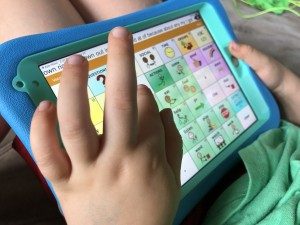
What are AAC Devices?
AAC devices are augmentative/alternative communication systems that allow a person to communicate with those around them without speaking. There are many different types of AAC but the most common are high-tech AAC Devices that allow a person to push a button to speak a message. These are helpful for children or adults who have either lost the ability to speak or who are not able to speak well enough to clearly communicate everything that they want to say. This includes some children with conditions such as autism, childhood apraxia of speech, and other types of speech/language delays. These devices are sometimes called “communication devices” or “talkers”. Learn more about the different types of AAC devices here.
When Should AAC Speech Therapy be Considered for a Child?
AAC should be considered for any child when his/her speech output is not adequate to communicate everything that the child wants/needs to communicate.
Things to consider:
- Child’s frustration levels
- Adult frustration levels
- Access to school curriculum
- Participation in classroom activities
- Ability to demonstrate knowledge to teachers
- Access to home and community environment
- Ability to interact appropriately with family and peers
- Independence in developmentally-appropriate daily activities
What Pre-Requisite Skills are Required Before Starting AAC Speech Therapy?
In short, there are no skills that a child MUST have before AAC can be tried. Though, here are a few of the common misconceptions about this:
These are commonly used as excuses why AAC devices should not be attempted with children but these are WRONG:
- Does the child need to understand cause and effect before starting AAC speech therapy? No! AAC teaches cause and effect quite effectively.
- Does the child need to understand that a picture represents an object? No! AAC use teaches this as well.
- Does the child need to have good motor skills for AAC? No! There are a lot of alternatives for children who can’t access a device with their hands
- Does the child need to understand language before starting AAC speech therapy? No! Babies don’t have great understanding of language before they are introduced to speech. Children can learn language through AAC use.
- Does the child need to be interested in communicating? No! Even challenging behaviors can be shaped into intentional communication using AAC
Click here for more information about pre-requisites (or the lack thereof) for AAC speech therapy
What are the Different Types of AAC Systems and Devices?
There are many different types of AAC systems and devices that can be used by children. Options for AAC devices, methods, and systems include
- Gestures/Body Language
- Sign Language
- Object Symbols (objects glued to cards)
- Picture Boards
- Picture Exchange
- Written Messages (paper or typed)
- Single Button Voice-Output Devices
- Multi-Button Voice-Output Devices
- Dynamic-Display Voice-Output Devices
How to Choose an AAC System or Device for Speech Therapy:
Often the decision of what type of AAC system the child uses is put up to a team of professionals that evaluates the child’s needs and abilities. These teams are typically called AAC teams and can be found at many larger hospitals across the country. If you don’t have access to such a team, here are a few things to consider when selecting a method:
- Child’s mobility and physical limitations
- Family preferences and limitations
- Number of different desired communication partners
- Child’s cognitive level
- Child’s visual and attention skills
- Likelihood of long-term AAC use
- Child/Family’s means of acquiring devices
- What the child will be using it for
- How well the child does when using the systems during trials or therapy
- Past success or failures with AAC systems
If nothing else, just pick something that seems suitable and give it a try with a child. You won’t know if it will work until you try. Many states and organizations have lending libraries that will help you decide if a device or system is right for a child.
How to Introduce an AAC System or Device in Speech Therapy
Make it as natural as possible. Think of it as similar to how you would encourage a late talker to talk.
- Get Familiar with the Child’s System
- Model AAC Use Around the Child
- Encourage the Child When he Attempts to Use it and Provide Differential Reinforcement
- Have the Device Present at All Times
- Set Up Opportunities for the Child to Use the AAC Device (in the classroom, at home, in speech, etc.)
- Train Other Adults on How to Set Up Opportunities and Provide Differential Reinforcement
Click Here for More Information on Introducing an AAC System
AAC Goals for Speech Therapy
To write a goal for AAC use, think about what goal you would set for the child if he was using speech instead of the device/system. Write goals for what the child will communicate, not for specific AAC use.
Examples:
Good Goals:
- Child will use single words to request foods during snack time, using spoken words, sign language, or an AAC device.
- Child will answer “who” questions by indicating the correct person using spoken words, sign language, or an AAC device.
- Child will create three-word utterances using an “I want…” carrier phrase through use of spoken words, sign language, or an AAC device.
Not-So-Good Goals:
- Child will push buttons on his AAC device to request.
- Child will use his AAC device during circle time.
- Child will answer yes/no questions using his AAC device.
- Child will find buttons on his AAC device when requested by the therapist.
- Child will hand a picture to the therapist during PECS training.
Sample AAC Goals for Beginning Communicators:
- By the end of the IEP cycle, Client will use language of some form (spoken words, sign language, or AAC) to communicate in the therapy setting at least 20 times during 15 minutes of therapy on 3 consecutive data collection days.
. - The client will use language of any type (spoken speech, sign language, or augmentative/alternative communication such as a picture board or talker) to make a choice between two options with verbal prompts as needed on 80% of observed opportunities.
. - By the end of the IEP cycle, the client will improve functional communication by using any form of language (spoken language, sign language, or a communication device/system) to communicate at least three different communicative intents (see below**) per 30-minute speech/language therapy session, on 2/3 data days, as measured by observation by the therapist.** Communicative intents could include requesting, protesting, refusing, commenting, labeling, answering, describing, asking, calling attention (“look”), or using social forms (such as greetings and “thank you”)
. - By the end of the IEP cycle, the client will answer basic yes/no questions about his wants and needs (ex: “do you want this”) by shaking/nodding his head or using language to convey yes/no on at least 80% of observed opportunities with repetitions as needed.
. - By the end of the IEP cycle, the client will use language to protest (using sign language, spoken language, or an AAC device) when he doesn’t want to do something while refraining from screaming and/or throwing things on 4 of 5 observed opportunities with visual and verbal reminders as needed.
For more ideas for encouraging functional communication, click here
How to Collect Data during AAC Speech Therapy
Once you have a really solid goal, you’ll need to track the child’s progress toward it. Here are a few ways to measure AAC goals:
- % of attempts: Track each time the child tries to accomplish a goal (like get something) and mark correct if the child uses language of some kind (ex: Child will use language to request during snack on 80% of attempts – Reaching, grabbing, crying, and grunting count as incorrect while using words, signs, or AAC count as correct)
- # of times in ___ minutes: Track how many times the child accomplishes the goal during a certain number of minutes (ex: Child will use language to request during snack at least 5 times in 5 minutes – Only AAC or spoken words count as correct)
- Rubric-style grading: With this type of data, you rate the child’s AAC use on a scale (such as from 1-5) based on how independently they use their system.
The method you use will depend on the type of goal you write and how you prefer to collect data, but this can be used to help you easily track if the child is making progress toward that goal.
Additional Resources for AAC Speech Therapy:

About the Author: Carrie Clark, MA CCC-SLP
Hi, I’m Carrie! I’m a speech-language pathologist from Columbia, Missouri, USA. I’ve worked with children and teenagers of all ages in schools, preschools, and even my own private practice. I love digging through the research on speech and language topics and breaking it down into step-by-step plans for my followers.
Fun Fact: Things always seem to work out for me. And by that, I mean that when I take a look at events in my life, I can always trace them back to the positive things that came out of them, even if they seemed awful at the time. So I choose to believe that everything always works out the way it needs to and the universe makes sure I have what I need.
Connect with Me:

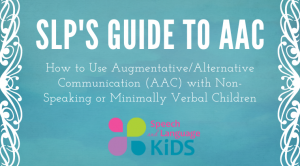
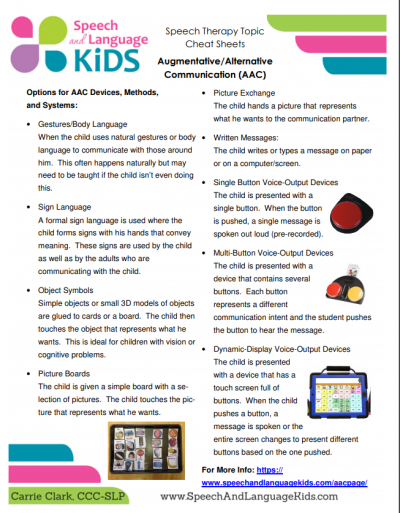
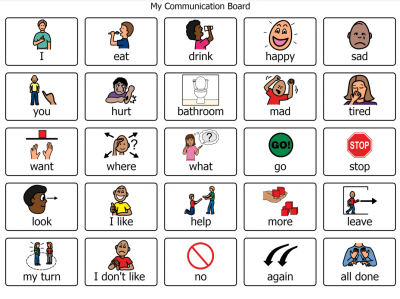
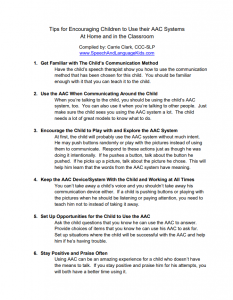
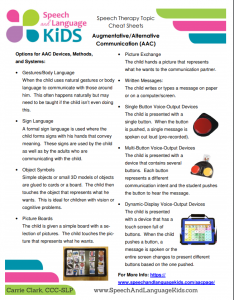
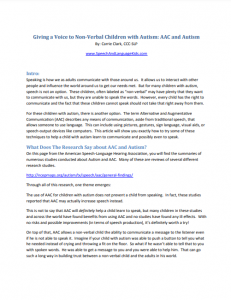







Thanks for sharing your idea which is very useful
Hi Carrie, I was trying to open the AAC cheatsheet that I signed up to get in my email. I have the email but the sheet when I try to open says 50% complete but never downloads.
Hi, Laura-We just emailed you a copy of the cheat sheet. Please let us know if you need anything else.
Hi,
I have been trying to download the AAC cheatsheet without success. It just does not download.
Hi, Brigitte-Please check your email, as we sent you a copy of the requested resource.
Thanks for sharing this type of information. Great Blog.